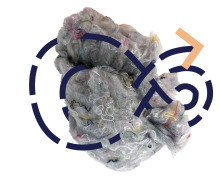4: WHO?

4: WHO?
Who needs to be involved in the utilisation of end-of-life textiles?
The circular economy of textiles requires changes and collaboration from various different actors throughout the value chain. In Finland, this ecosystem has been built for a long time – the most important contributor being the Telaketju collaboration network and related projects. In this chapter, we cover what is meant with the ecosystems of circular economy and recycled textile fibre and who belong in them. You will also get tips on how to get involved in them!
Podcasts
Podcast # 5 relates to this theme. Find it here!
A circular economy ecosystem refers to a network, in which multiple actors from various sectors – companies, research and educational organisations as well as public actors – collaborate past industry boundaries with the goal of producing products and services that complete each other and enable maintaining material value in the society for as long as possible. The goal may also be to develop novel know-how and production resources. In regards to advancing a circular economy, these types of ecosystems are vital because a circular economy requires often extensive collaboration both within and beyond value chains. An industrial symbiosis is an example of a circular economy ecosystem.
In Finland, there has been persistent efforts towards a circular economy of textiles, and Finland is, indeed, one of the frontrunners in circularity on the EU-level. Important pieces in the circular textile ecosystem are the end-of-life textiles refinement plant in Paimio, textile consumers and collection of end-of-life textiles, utilisers of recycled textile fibre and various research, development and innovation organisations, such as VTT.
However, there are still missing links in the value chain in order to manufacture high value products from the recycled textile fibre in Finland. Currently, there is, for example, no industrial scale yarn making in Finland. According to VTT’s research report, Finland has an opportunity to strengthen the textile industry based on biomaterials and the circular economy. This is supported by the Finnish know-how in bio-based raw materials, smart technologies and industrial processes. Strengthening the circular textile ecosystem requires collaboration in different market areas and expanding the value chains of recycled textiles globally.
References
Finixrevolution (1.9.2020) Solving the systemic challenges in textile industry: Samuli Patala / Aalto Business.
Sitra (2018) Mitä nämä käsitteet tarkoittavat?
Sitra. Teolliset symbioosit.
Samuli Patala, Assistant Professor, Aalto University (16.3.2021) Teollisten symbioosien johtaminen
Kamppuri, T., Kallio, K., Mäkelä, S., Harlin, A. (2021) Finland as a forerunner in sustainable and knowledge-based textile industry – Roadmap for 2035. VTT Technical Research Centre of Finland.
Satumaija Levón, sustainability and circular economy expert, Suomen Tekstiili & Muoti ry, Kuituus podcast, episode 1
4.2
The benefits and prerequisites of the ecosystem
The experts from Kuituus Twitter live discussions see multiple benefits in circular economy ecosystems. It is an opportunity to be a frontrunner and strengthen the company brand image, to learn new things and to develop business as well as innovation. In ecosystems, it is possible to share know-how, resources and networks, and in this way, make operations more efficient. Collaboration with other actors may enable more visibility and open up possibilities that would be out of reach for a single operator – such as new business models, financing models and markets. In addition, belonging to a circular economy ecosystem can be an important part of the company’s sustainability and it helps in responding to both consumer and legislative demands.
Trust between the actors and a shared goal are in the heart of a functioning ecosystem. The ecosystem should create added value for each party, and it requires openness and sharing information – and if needed, also appropriate technology to enable the ecosystem’s operations. The actors in the ecosystem should create products and services that complete one another, and therefore, each party should benefit from the ecosystem. Appropriate communication and facilitation are needed as well. Various circular economy schemes or public organisations could be suitable as an impartial facilitator for the ecosystem.
References
Expert discussion, Kuituus Twitter-live 3, 9.6.2021
4.3
How to get involved in the recycled textile fibre ecosystems?
Getting involved in different schemes or projects is a good way to kick off the work towards circular business and to get involved in central ecosystems. Below are listed some central actors in the Finnish context.
Telaketju is an active collaboration network that focuses on advancing the sustainable production, use and circulation of textiles. There are multiple related projects, and for instance, the end-of-life textile refinement plant in Paimio originated in one of them.
Aalto University’s FINIX-project aims at advancing sustainable textile systems and does research on new sustainable materials, digitalisation and the circular economy, among other things. FINIX also collaborates with the private sector.
FISS, i.e. the Finnish Industrial Symbiosis System is a collaborative model that aims at assisting companies to share resources more efficiently and to build new business.
For example, the Finnish Textile & Fashion offers good resources for someone interested in the circular economy of textiles. It is also worthwhile to network by contacting interesting actors and by participating in events.
Central actors in the Finnish circular textile ecosystems are Rester and Lounais-Suomen Jätehuolto. Their end-of-life textiles refinement plants enable the building of a larger circular ecosystem and circular business activity within the textile industry in Finland.


